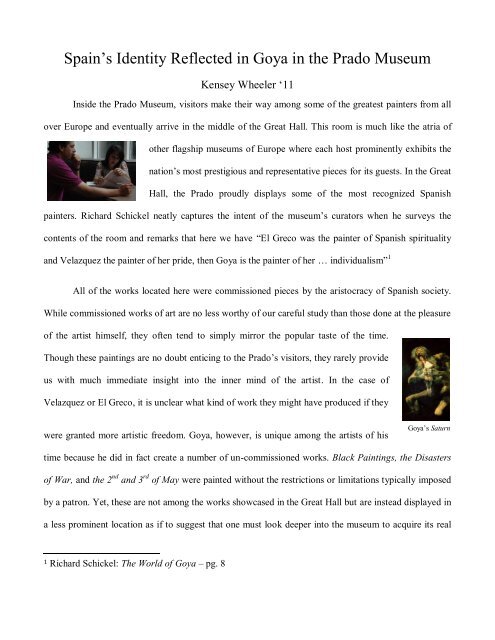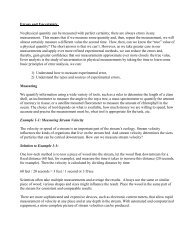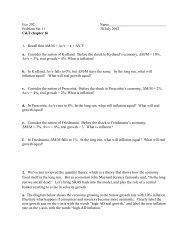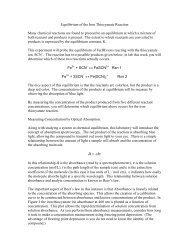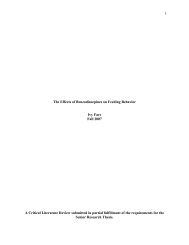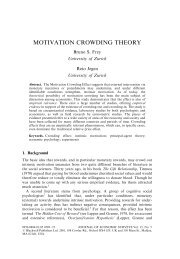Spain's Identity Reflected in Goya in the Prado Museum
Spain's Identity Reflected in Goya in the Prado Museum
Spain's Identity Reflected in Goya in the Prado Museum
Create successful ePaper yourself
Turn your PDF publications into a flip-book with our unique Google optimized e-Paper software.
Spa<strong>in</strong>‟s <strong>Identity</strong> <strong>Reflected</strong> <strong>in</strong> <strong>Goya</strong> <strong>in</strong> <strong>the</strong> <strong>Prado</strong> <strong>Museum</strong><br />
Kensey Wheeler „11<br />
Inside <strong>the</strong> <strong>Prado</strong> <strong>Museum</strong>, visitors make <strong>the</strong>ir way among some of <strong>the</strong> greatest pa<strong>in</strong>ters from all<br />
over Europe and eventually arrive <strong>in</strong> <strong>the</strong> middle of <strong>the</strong> Great Hall. This room is much like <strong>the</strong> atria of<br />
o<strong>the</strong>r flagship museums of Europe where each host prom<strong>in</strong>ently exhibits <strong>the</strong><br />
nation‟s most prestigious and representative pieces for its guests. In <strong>the</strong> Great<br />
Hall, <strong>the</strong> <strong>Prado</strong> proudly displays some of <strong>the</strong> most recognized Spanish<br />
pa<strong>in</strong>ters. Richard Schickel neatly captures <strong>the</strong> <strong>in</strong>tent of <strong>the</strong> museum‟s curators when he surveys <strong>the</strong><br />
contents of <strong>the</strong> room and remarks that here we have “El Greco was <strong>the</strong> pa<strong>in</strong>ter of Spanish spirituality<br />
and Velazquez <strong>the</strong> pa<strong>in</strong>ter of her pride, <strong>the</strong>n <strong>Goya</strong> is <strong>the</strong> pa<strong>in</strong>ter of her … <strong>in</strong>dividualism” 1<br />
All of <strong>the</strong> works located here were commissioned pieces by <strong>the</strong> aristocracy of Spanish society.<br />
While commissioned works of art are no less worthy of our careful study than those done at <strong>the</strong> pleasure<br />
of <strong>the</strong> artist himself, <strong>the</strong>y often tend to simply mirror <strong>the</strong> popular taste of <strong>the</strong> time.<br />
Though <strong>the</strong>se pa<strong>in</strong>t<strong>in</strong>gs are no doubt entic<strong>in</strong>g to <strong>the</strong> <strong>Prado</strong>‟s visitors, <strong>the</strong>y rarely provide<br />
us with much immediate <strong>in</strong>sight <strong>in</strong>to <strong>the</strong> <strong>in</strong>ner m<strong>in</strong>d of <strong>the</strong> artist. In <strong>the</strong> case of<br />
Velazquez or El Greco, it is unclear what k<strong>in</strong>d of work <strong>the</strong>y might have produced if <strong>the</strong>y<br />
were granted more artistic freedom. <strong>Goya</strong>, however, is unique among <strong>the</strong> artists of his<br />
<strong>Goya</strong>‟s Saturn<br />
time because he did <strong>in</strong> fact create a number of un-commissioned works. Black Pa<strong>in</strong>t<strong>in</strong>gs, <strong>the</strong> Disasters<br />
of War, and <strong>the</strong> 2 nd and 3 rd of May were pa<strong>in</strong>ted without <strong>the</strong> restrictions or limitations typically imposed<br />
by a patron. Yet, <strong>the</strong>se are not among <strong>the</strong> works showcased <strong>in</strong> <strong>the</strong> Great Hall but are <strong>in</strong>stead displayed <strong>in</strong><br />
a less prom<strong>in</strong>ent location as if to suggest that one must look deeper <strong>in</strong>to <strong>the</strong> museum to acquire its real<br />
1 Richard Schickel: The World of <strong>Goya</strong> – pg. 8
lesson for <strong>the</strong> spectator. To f<strong>in</strong>d <strong>the</strong> artist‟s m<strong>in</strong>d freely at work, we must w<strong>in</strong>d back down <strong>the</strong> stairs to<br />
ano<strong>the</strong>r w<strong>in</strong>g of <strong>the</strong> museum that is tucked away from <strong>the</strong> regular traffic of daily<br />
life. There is someth<strong>in</strong>g fitt<strong>in</strong>g about where <strong>the</strong>se works are placed <strong>in</strong> <strong>the</strong> museum.<br />
Depiction from <strong>Goya</strong>‟s<br />
Disasters of War<br />
Unlike <strong>the</strong> commissioned works that celebrate Spa<strong>in</strong>‟s history and way of life,<br />
<strong>Goya</strong>‟s non-commissioned pa<strong>in</strong>t<strong>in</strong>gs wrestle with <strong>the</strong> nation‟s complicated and often tragic history.<br />
Unlike <strong>the</strong> edify<strong>in</strong>g pa<strong>in</strong>t<strong>in</strong>gs located <strong>in</strong> <strong>the</strong> Great Hall, <strong>the</strong>se works, <strong>in</strong> <strong>the</strong>ir graphic and gruesome<br />
detail, depict some of <strong>the</strong> most significant moments <strong>in</strong> <strong>the</strong> development of Spa<strong>in</strong>‟s nationalism.<br />
Spa<strong>in</strong> is unique among <strong>the</strong> o<strong>the</strong>r nation-states of Europe. Typically, nationalism is formed<br />
around a common culture or ethnicity. However, Spa<strong>in</strong> is a nation that houses many different cultures<br />
and, <strong>in</strong> many cases, <strong>the</strong> citizens don‟t even share a common language. Spa<strong>in</strong>, also, does not have what<br />
o<strong>the</strong>r modern enlightenment nations share: a successful revolutionary moment, where <strong>the</strong> residents were<br />
suddenly united as one people <strong>in</strong> a common revolutionary cause aga<strong>in</strong> <strong>the</strong> feudal oppressors.<br />
Never<strong>the</strong>less, <strong>the</strong>re is someth<strong>in</strong>g that still that unites Spa<strong>in</strong> as a nation. Spa<strong>in</strong>‟s tragic past has not been<br />
led to its dissolution as so often happens <strong>in</strong> history, but ra<strong>the</strong>r <strong>the</strong>se trials and tribulations are <strong>the</strong> very<br />
material from which <strong>the</strong> country has cultivated its own solidarity.<br />
In order to completely understand this political evolution and subsequently <strong>the</strong> concepts that are<br />
seem<strong>in</strong>gly depicted <strong>in</strong> works done by <strong>Goya</strong>, one must, like <strong>the</strong> guests of <strong>the</strong> <strong>Prado</strong>, meander <strong>the</strong>ir way<br />
through <strong>the</strong> complicated history of Spa<strong>in</strong>. Thus, when enter<strong>in</strong>g <strong>in</strong>to <strong>the</strong> room<br />
where <strong>the</strong>se works are exhibited <strong>in</strong> <strong>the</strong> <strong>Prado</strong>, it is appropriate that only those<br />
who understand <strong>the</strong> complexities beh<strong>in</strong>d <strong>the</strong>se works are able to f<strong>in</strong>d and enjoy<br />
<strong>Goya</strong>‟s 3 rd of May<br />
1808<br />
<strong>the</strong>m. <strong>Goya</strong>‟s Black Pa<strong>in</strong>t<strong>in</strong>gs and his Disasters of War are no façade for outsiders but a witness to <strong>the</strong><br />
<strong>in</strong>ner truth of Spanish nationalism. Here I will attempt to demonstrate how <strong>Goya</strong>‟s works <strong>in</strong> this room<br />
are designed to illustrate <strong>the</strong> possibilities and limitations of modern politic for Spa<strong>in</strong>.


